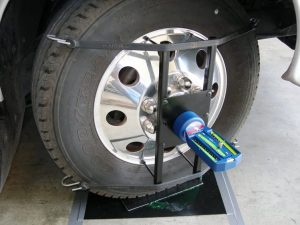Tips For A Better Service Experience | Understanding Front End Alignment Problems to Communicate with Your Technician
There’s no doubt that the longer you drive your truck, the more you learn to communicate with it. You’re working partners, day in and day out. So it’s like an old friend – you know its foibles, and you could finish its sentences if the truck could actually talk. So when it doesn’t feel right as you’re driving, you know it’s time for a front end alignment. You schedule the work.
 But you might be wrong.
But you might be wrong.
Skilled as you are behind the wheel, and familiar as you are with your rig, your truck’s service technician is also skilled. Especially if he’s part an Elite Support team. He’s trained to look for all possible causes when there’s a problem. And he can’t do his job unless you communicate with him. The symptoms you’re noticing might indeed be caused by the need for a front end alignment, but they could also indicate another problem altogether. Maybe a wheel is out of balance.
Let’s take a closer look at the symptoms that often point to alignment or wheel balance issues. When you dig deeper, you’ll be better able to help your technician diagnose the problem. The result? A more satisfying service experience for you.
Constant vibration or shaking at any speed:
- Bent wheel
- Bad tire
Constant vibration or shaking at only certain speeds or speed ranges:
- One or more wheels out of balance
Constant vibration felt in the steering wheel:
- Problem somewhere in the front wheels
Constant vibration felt in the seat:
- Problem with the rear wheels
Vibration only when you hit a bump:
- Loose front wheel bearings
- Loose or worn parts in the suspension or steering
Drift or pull:
Whether the truck is drifting gradually or darting rapidly to the right or left, the cause is usually improper tire inflation. Constant pulling in one direction or the other could also be “radial pull,” if you’re running radial tires. This can happen even if the tires are new. An easy way to tell is to switch tires side-to-side and see if the problem goes away. If it does, that indicates radial pull.
Your truck will also want to drift right or left if the steering alignment is off or if steering parts have become worn.
Why does Elite Support matter?
The key to expert diagnosis of any truck problem is working with top-of-the-line technicians. You can be confident you’re working with the best when you choose an Elite Support shop. This program is a collaborative effort between selected dealers and Daimler Trucks North America, specifically created to improve customer service at Freightliner and Western Star dealerships.
To earn Elite Support status, dealers must go beyond excellence in the quality of their work. They have to meet superior standards for speedy diagnostics and turnaround time for service or repairs. They also have to prove themselves by meeting higher standards for not-so-little extras. These include providing amenities for customers who are waiting and maintaining constant communication with customers about service progress, whether customers are waiting onsite or elsewhere.
Here at Tracey Road Equipment, we are very proud to be an Elite Support Dealer. It underscores our commitment to each of our customers – to build a long-term working relationship you can rely on to keep your truck (or entire fleet) on the road and working.
